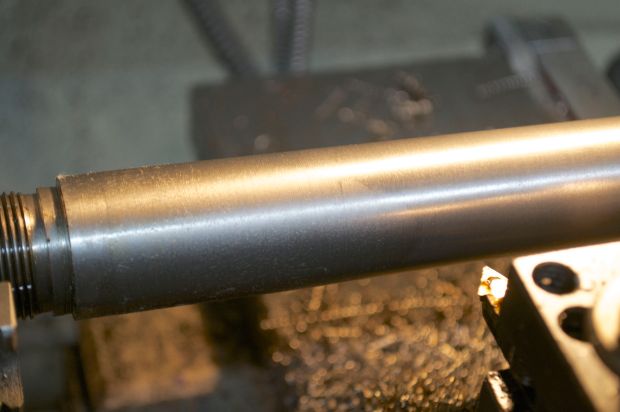
In this post I’ll be turning a straight taper on a rifle barrel. The barrel is an unturned (straight 1.250″ diameter) gunsmith blank. A straight taper is the easiest taper to cut on a barrel. Barrel with curved profiles, such as sporter contours, are more challenging. Check out this link to see a few different examples of barrel contour specifications.
This barrel is a Shilen Match grade, 1:10 twist, stainless steel blank. It was used for my post 308 Winchester / 7.62x51mm NATO: Barrel Length versus Velocity (28″ to 16.5″). Because of this, it has already been threaded, chambered and cut to 16.5″ in length. Ideally, you’d want to taper the barrel before it was threaded and chambered. You would also want to have at least an inch extra on each end.
If your lathe is equipped with a tapering fixture, tapering is a breeze. For this post I will not be using the tapering fixture, instead I will be tapering the barrel using the offset tail stock method. First, I’ll need to determine how much the barrel needs to be tapered.
I decided on trying to copy the barrel taper found on the DARPA XM-3 rifle. According to “The Darpa XM-3” by Steve Reichert, the 18.5 inch long barrel has a modified Hart #7 contour. It has a 2″ straight shank and a muzzle diameter of .850″. From his article, I wasn’t able to determine if the shank is 1.250″ or 1.200″, so I elected to use 1.200″. Obviously, since my barrel is only 16.5″ long I can’t make an exact copy, but I can copy the taper.
Since the source states a 2″ shank and 18.5″ overall length, I know the taper is 16.5″ long (18.5″-2″=16.5″). At the shank, it is 1.200″ and the muzzle is .850″. This means the barrel tapers .350″ (1.200″-.850″=.350″) over 16.5″. Since the lathe will remove material on both sides of the barrel, I will divide this in half (.350″/2=.175″). To determine the taper per inch, I simply divide this number by the length of the taper (.175″/16.5″= .0106) and get a value of .0106″ per inch of barrel. Since my blank is 16.5″ long, I’ll need to offset the end of the barrel .1749″ (16.5x.0106″=.1749″).
Finally, I’ll need to calculate the muzzle diameter. Since the XM-3 has a .850″ muzzle diameter at 18.5″, I need to determine its diameter at 16.5″. I simply multiply the taper per inch, by 2 for its location on the barrel (2″ from the muzzle), and by 2 again since this is the taper on the radius for a value of .042″ (.0106″x2X2=.042″). .042″ is added to .850″ (.850″+ .042″=.892″) for a final muzzle diameter of .892″.
I’ll be using the following parts from Brownells:
- Shilen .308 1:10 match grade stainless steel unturned barrel blank
- Surefire brake
- 3/8″ High-speed steel turning tools
- Viper’s Venom cutting oil
- Starrett dial indicator
- Starrett dial calipers
- Manson floating reamer holder
The contents of Rifleshooter.com are produced for informational purposes only and should be performed by competent gunsmiths only. Rifleshooter.com and its authors, do not assume any responsibility, directly or indirectly for the safety of the readers attempting to follow any instructions or perform any of the tasks shown, or the use or misuse of any information contained herein, on this website.
All lathe work is conducted on a Grizzly gunsmith’s lathe.





















It is too short to work with the TACMOD chassis forend (above)so now it is on the MDT LSS chassis (below). The bottom picture is the first group I shot with the rifle, 5-shots, .785″ including cold bore.
If you liked this post, check out Project Guns- Gunsmithing articles and posts and subscribe to Rifleshooter.com (top right corner of page).






You must be logged in to post a comment.